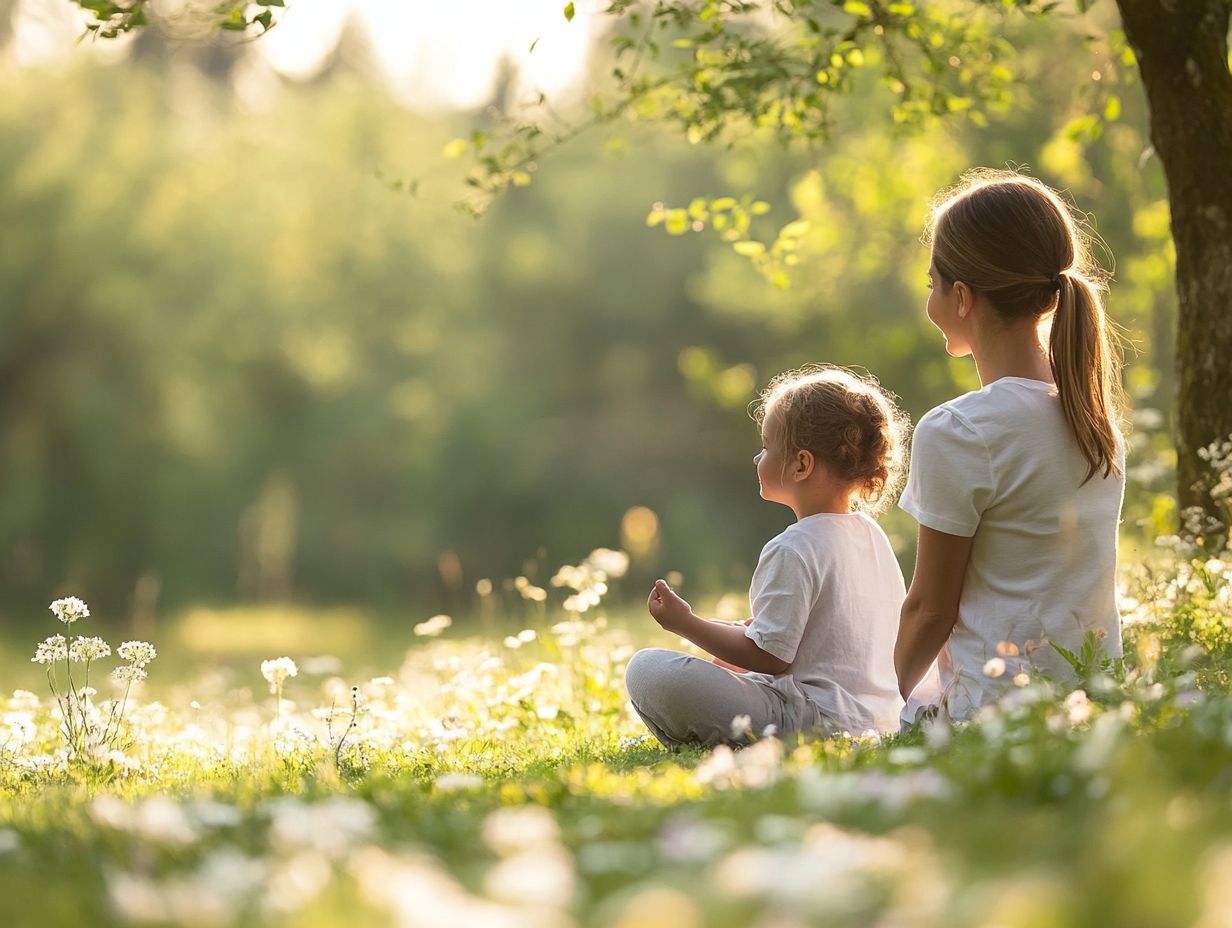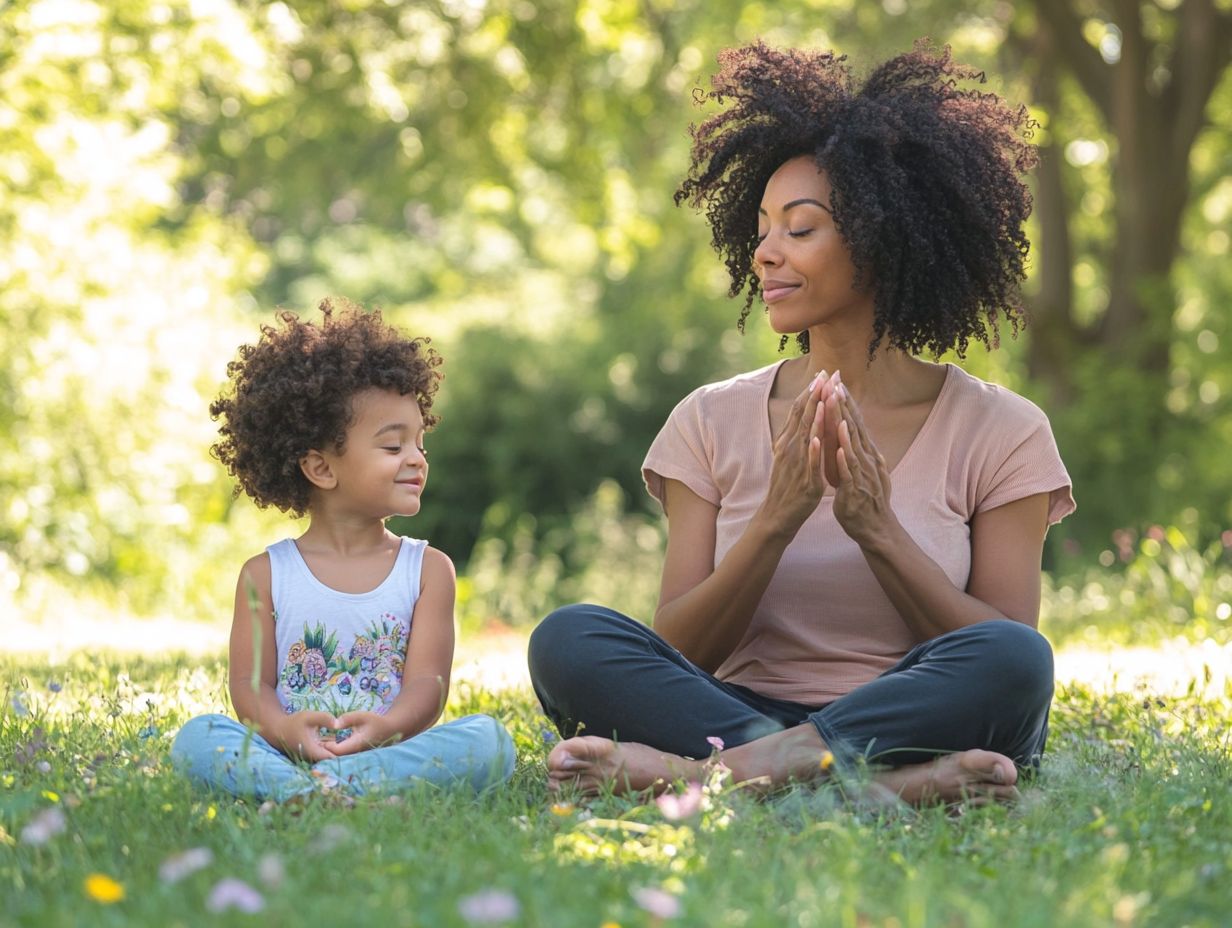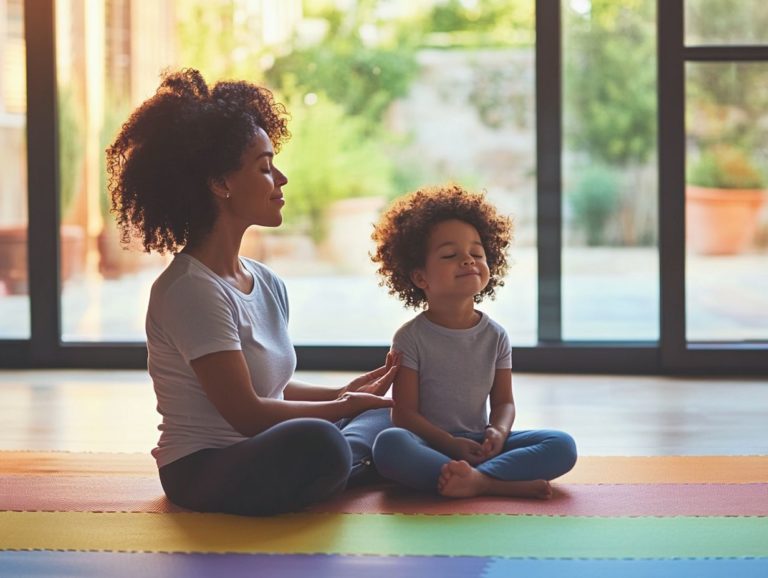5 Quick Mindfulness Exercises for Parents
Contents
- Mindfulness Exercises for Busy Parents
- Key Takeaways:
- 1. Breathing Exercises
- 2. Body Scan Meditation
- 3. Gratitude Practice
- 4. Mindful Walking
- 5. Visualization Techniques
- How Can Mindfulness Help Parents?
- What Are Some Tips for Parents to Maintain a Consistent Mindfulness Practice?
- Frequently Asked Questions
- What are 5 quick mindfulness exercises for parents?
- How can these mindfulness exercises benefit parents?
- When should I do these exercises?
- Do I need any special equipment or training to do these exercises?
- Can I involve my children in these exercises?
- Are there any other resources or tools I can use to incorporate mindfulness into my parenting?
Mindfulness Exercises for Busy Parents
Parenting is a journey that can be as rewarding as it is overwhelming, often leaving little room for the essential act of self-care. Incorporating mindfulness into your daily routine can transform this journey, making it more manageable and fulfilling.
This article delves into five quick mindfulness exercises specifically designed for busy parents, featuring techniques like breathing exercises, body scan meditation, and gratitude practices. You ll uncover how these methods can elevate your well-being, foster self-regulation, and cultivate a calmer atmosphere at home.
We will also address the common challenges you might encounter while trying to maintain mindfulness and offer practical tips for involving your children in these enriching practices. Embrace the path toward a more mindful parenting experience, where compassion and emotional support play a crucial role!
Key Takeaways:

- Breathe to stay present and calm in challenging parenting moments.
- Practice gratitude to appreciate small moments and shift perspective.
- Include children in mindfulness exercises to bond and teach them valuable coping skills.
- Incorporate mindfulness techniques such as a mindfulness jar or guided meditations to enhance self-regulation and emotional intelligence.
1. Breathing Exercises
Breathing exercises serve as a vital element of mindfulness practices. They provide you with a powerful tool for stress reduction and self-regulation. This helps nurture a calm connection with your children during tough times. By weaving various breathing techniques into your daily routines, you not only enhance your emotional awareness but also model these invaluable skills for your children. This promotes their early childhood development and emotional intelligence. Mindful mornings can set a positive tone for the day, benefiting both you and your children’s well-being.
For example, consider the “Belly Breathing” exercise. You and your children take deep breaths through your noses, allowing your bellies to expand. This simple practice can create a soothing atmosphere that benefits everyone involved. Try incorporating a feelings chart to help children articulate their emotions during these exercises.
Another engaging activity is “Bubble Breathing”. Your children pretend to blow bubbles, taking slow, deep breaths while visualizing their worries drifting away with each bubble they create. This is an excellent example of mindfulness activities that engage children’s attention and creativity.
Such practices not only foster a harmonious environment but also cultivate teamwork and support within your family. By regularly practicing these exercises together, you can enhance emotional regulation, awareness development, and resilience, leading to healthier communication and stronger bonds during stressful times.
2. Body Scan Meditation
Body scan meditation means focusing on different parts of your body to understand how you feel. It is a transformative mindfulness practice that invites you to cultivate self-awareness and emotional insight. By guiding your attention to various parts of your body, this practice promotes relaxation and fosters a deeper understanding of your feelings. For parents, it can be especially beneficial, allowing you to connect with your emotions and create a serene environment for your children. This ultimately enhances family dynamics and overall well-being. Try using mindfulness-based classes or apps, such as Insight Timer, for a fun way to practice together!
To embark on a body scan meditation, seek out a quiet and comfortable space where both you and your children can sit or lie down, free from distractions. Start by taking a few deep breaths, letting your body relax more with each exhale. Then, gently direct your focus to your toes, noticing any sensations or tension before gradually moving upwards through your feet, legs, and into your torso. You can also incorporate mindfulness of sounds to deepen the experience.
This process of concentrating on and releasing tension not only aids in emotional regulation but also helps you and your children identify your feelings more clearly. By integrating this practice into your family routines perhaps before bedtime or after school you can establish a comforting ritual that strengthens emotional bonds and encourages open conversations about feelings.
Don’t wait! Start incorporating these mindfulness exercises today!
3. Gratitude Practice
A gratitude practice serves as an exceptional mindfulness technique that enhances emotional awareness and fortifies family connections. It encourages both parents and children to pause and reflect on, as well as express, their appreciation for the positive aspects of their lives. By nurturing an attitude of gratitude, you can help your family enhance their emotional vocabulary and foster self-compassion, ultimately paving the way for greater emotional intelligence and resilience in your children.
Implementing gratitude practices can take various forms. You might consider maintaining a gratitude journal, where each family member records what they appreciate. You can also spark daily discussions about what each person is thankful for. These simple yet profound rituals enable your family to recognize the good in daily life while creating shared moments of reflection that deepen your bonds.
Engaging in mindful interactions and compassionate conversations can further enhance these gratitude practices. Over time, consistent expressions of gratitude can lead to improved emotional well-being, reduced anxiety, and stronger family dynamics, making it easier for everyone to tackle challenges together.
To ensure that gratitude becomes a lasting habit, schedule a regular gratitude-sharing time perhaps during dinner or before bedtime transforming it into a cherished family tradition. This practice also promotes cognitive functions linked to positive thinking and emotional resilience.
4. Mindful Walking

Mindful walking is a remarkably effective mindfulness technique that invites you to cultivate awareness of your movements and the environment around you. It serves as an excellent opportunity for parents and children to bond while helping everyone enjoy the present moment. Incorporate sensory explorations to deepen the experience and foster attention to emotions as they arise.
As you embark on sensory explorations during your walks, you ll find that your family s connection deepens, fostering a greater understanding of emotions and feelings, ultimately enhancing emotional intelligence. These walks can also serve as opportunities for mindfulness practices for families, promoting shared moments of discovery and connection.
Focus on each step and the sensations that arise to turn ordinary strolls into unforgettable adventures. To seamlessly weave mindful walking into your daily routines, consider designating a specific day each week for family walks, encouraging everyone to set aside distractions.
During these walks, take the time to pause and invite your children to share their observations what they see, hear, or feel. This practice nurtures a deeper understanding of their surroundings and their emotional responses. By asking open-ended questions about their observations, you not only promote emotional awareness but also strengthen family bonds, creating treasured moments of connection and communication.
5. Visualization Techniques
Visualization techniques serve as potent mindfulness tools that enable you to create mental images of positive outcomes, enhancing emotional regulation and self-awareness, particularly in those challenging parenting moments. By encouraging your children to visualize their feelings and desired behaviors, you can foster emotional support and enrich their emotional vocabulary, enabling them to set positive goals and manage their emotions with greater efficacy. This approach works wonders for handling tricky behaviors and promoting self-compassion in children.
In everyday situations, you can guide your children through simple visualization exercises. For instance, when they feel overwhelmed or anxious, you might suggest they imagine a calm and happy place. Take the first day of school as an example; during this potentially stressful moment, you could encourage your child to close their eyes and visualize walking confidently into the classroom, greeted by friendly smiles from their peers. This method effectively integrates mindfulness and compassion into your daily parenting strategies.
These techniques not only assist children in articulating their emotions but also enable them to develop vital self-regulation skills. By promoting such mental practices, you cultivate a nurturing environment where your children learn to navigate their feelings and reduce anxiety, paving the way for healthier emotional development. Tools like a mindfulness jar can be particularly helpful in visualizing and managing emotions.
How Can Mindfulness Help Parents?
Mindfulness can be a game changer for you as a parent, providing essential tools for managing stress, enhancing emotional intelligence, and deepening your connections with your children amid the ups and downs of parenting. By cultivating mindful awareness, you can elevate your self-regulation skills, leading to more compassionate interactions and healthier family dynamics. This approach ultimately benefits not only your own well-being but also supports your children’s emotional growth. Consider exploring mindfulness and compassion programs tailored for families to make this journey even more enriching.
Research indicates that practicing mindfulness can significantly lower your anxiety and stress levels, paving the way for clearer thinking and more thoughtful responses. For example, when you take a moment to breathe deeply before reacting to a frustrating situation, you’re more likely to respond with patience instead of irritation. Mindful listening is another powerful tool that can help in these situations, fostering better communication and understanding.
Incorporating simple strategies, like mindful breathing during stressful moments or keeping a daily gratitude journal, can easily fit into your daily routine. By prioritizing mindfulness, you equip yourself with valuable coping mechanisms while also modeling emotional intelligence for your children, teaching them the importance of self-awareness and empathy. Additionally, practicing mindful yoga can provide both physical and mental benefits, enhancing overall family well-being. You can also explore mindful games to play with your children to foster connection and awareness.
What Are the Benefits of Practicing Mindfulness as a Parent?
Practicing mindfulness as a parent brings a wealth of benefits, including heightened emotional awareness, reduced stress, and enhanced communication skills each of which is vital for fostering positive parenting outcomes. By being fully present and attentive, you can gain deeper insights into your children’s needs and emotions, creating a nurturing environment that cultivates emotional intelligence and resilience in them. Integrating self-care activities into your routine can further support this mindful parenting approach.
This mindful approach encourages better emotional regulation, enabling you to respond thoughtfully rather than react impulsively when faced with challenging situations. Research in developmental psychology shows that mindful parents often demonstrate increased patience, which allows for a calmer response to their child’s tantrums or frustrations. Experts like Dr. Mark Bertin emphasize the importance of mindfulness in parenting strategies, particularly for families dealing with ADHD or other challenges.
Furthermore, mindfulness improves family communication as you learn to actively listen and engage without preconceived judgments, effectively modeling healthy relational patterns for your children. Integrating simple exercises, such as deep-breathing techniques or brief moments of focused reflection, into your daily routines can help you cultivate a mindful approach that benefits the entire family. This approach supports early childhood development by fostering emotional intelligence and self-regulation.
How Can Parents Incorporate Mindfulness into Their Daily Routine?

Imagine starting your day with peace and connection let’s explore how mindfulness can do just that! Incorporating mindfulness into your daily routine can profoundly elevate your ability to connect with your children and manage stress, making it essential for nurturing a healthy family dynamic.
Simple techniques such as mindful mornings, breathing techniques for mindful parenting, and family mindfulness activities can effortlessly weave mindfulness into everyday life, bringing benefits to both you and your children. These practices can also serve as effective parenting strategies for handling challenging behaviors.
Start by carving out a few minutes each morning for mindful stretches or yoga. Invite your children to join you. This fosters a sense of calm and focus as you all prepare for the day ahead. Practicing mindful breathing techniques together, like counting breaths or visualizing a peaceful place, can become a cherished comforting ritual. Incorporating tools to improve parental mindfulness can further enhance your family’s mindfulness journey.
Engage in nature walks as a family, taking turns to share what you see, hear, and feel. This not only enhances awareness but also sparks meaningful discussions. Remember, consistency is key. Set aside a specific time each day for these activities, and you’ll find that it supports individual growth while strengthening family bonds.
Incorporating various awareness activities can further enhance mindful interactions and emotional connection within the family. Mindfulness will transform from an obligation into a shared exploration that everyone looks forward to.
What Are Some Common Challenges Parents Face When Trying to Practice Mindfulness?
Parents face many challenges when practicing mindfulness. These include time constraints, distractions, and maintaining focus amid the whirlwind of parenting demands.
Recognizing these obstacles is vital for devising effective strategies that prioritize self-care and emotional support. This enables you to embrace mindfulness more effortlessly and consistently. You can also integrate small snippets of mindfulness into your daily routine.
Finding a few precious moments for yourself in your bustling schedule may seem daunting. However, simple techniques, like taking a moment to breathe deeply while waiting for the kettle to boil or reflecting on gratitude during routine tasks, can yield substantial benefits. These small practices contribute to overall stress reduction and promote emotional awareness.
Cultivating a nurturing environment that promotes mindfulness benefits not just you but your children as well, creating a culture of self-awareness within the family. Community discussions further reinforce this idea, highlighting that self-care is far from selfish; it is essential for the holistic well-being of your family.
How Can Parents Involve Their Children in Mindfulness Exercises?
Involving your children in mindfulness exercises can greatly enhance their emotional awareness and strengthen family connections, transforming mindfulness into a shared journey. By participating in simple activities such as mindfulness jars, guided meditations, and breathing exercises together, you can equip your children with essential skills for managing their emotions and improving family dynamics.
Using tools like a feelings chart can help your children build a rich emotional vocabulary and facilitate discussions about their emotions. These engaging practices not only help your youngsters focus and remain present, but they also foster open conversations about feelings and experiences.
For example, setting aside just a few minutes each day for a family breathing exercise can turn mundane routines into calming rituals. You might also introduce mindfulness exercises for family time, where the family explores nature while paying close attention to the sights and sounds around them, deepening their appreciation for the environment.
Sharing these enriching experiences nurtures relationships and cultivates emotional intelligence, ensuring that your children learn the vital importance of empathy and self-regulation within a supportive atmosphere.
What Are Some Tips for Parents to Maintain a Consistent Mindfulness Practice?
Maintaining a consistent mindfulness practice can be particularly challenging for you as a parent. However, with intentional strategies and a genuine commitment to self-care, it becomes achievable. This practice can profoundly enhance your family life. By setting positive goals, establishing regular routines, and incorporating mindfulness exercises into family activities, you can create a sustainable mindfulness practice that benefits everyone involved. Enrolling in mindfulness-based classes with your family can provide additional structure and support.
To seamlessly integrate mindfulness into your daily routines, consider scheduling specific times for self-care. Even if it s just a few moments of quiet reflection or deep breathing amid your bustling schedule, it s beneficial. Engaging with accountability partners, whether friends or family members, can provide the motivation and encouragement you need. These practices can enhance how we think and process information and emotional resilience, supporting your overall mindfulness journey.
It s important to remember that integrating mindfulness doesn t have to be rigid. Adapting practices to align with your family’s dynamics allows for a natural flow.
Embracing this approach emphasizes flexibility and highlights that cultivating mindfulness is an ongoing journey, enriching the lives of both you and your children.
Frequently Asked Questions

What are 5 quick mindfulness exercises for parents?
- Breathing Exercises: Take a few moments to focus on your breath, inhaling deeply and exhaling slowly. This can help bring a sense of calm and clarity to your mind.
- Mindful Walking: Take a short walk, paying attention to each step and the sensations in your body. This can help ground you in the present moment.
- Gratitude Practice: Take a moment to think of three things you are grateful for. This can help shift your perspective to a more positive one.
- Body Scan: Close your eyes and scan your body, noticing any areas of tension or discomfort. This can help you release any physical tension and relax.
- Sensory Awareness: Take a few minutes to focus on each of your senses, noticing the sights, sounds, smells, tastes, and sensations around you. This can help you become more present and mindful in your surroundings.
How can these mindfulness exercises benefit parents?
Practicing mindfulness can help parents reduce stress, increase self-awareness, improve focus and attention, enhance emotional regulation, and cultivate a sense of calm and well-being.
When should I do these exercises?
These exercises can be done at any time. However, it may be helpful to incorporate them into your daily routine, such as first thing in the morning or before bed. This can help set a positive tone for your day or promote relaxation for a better night’s sleep.
Do I need any special equipment or training to do these exercises?
No, these exercises can be done anywhere and at any time without any special equipment. If you are new to mindfulness, you may benefit from attending a workshop or class to learn more about the practice.
Can I involve my children in these exercises?
Absolutely! Children can benefit from practicing mindfulness as well. You can adapt these exercises to make them more child-friendly, such as using fun visualizations or incorporating movement.
Are there any other resources or tools I can use to incorporate mindfulness into my parenting?
Yes, there are many resources available, such as books, apps, and online courses, that can provide more information and guidance on incorporating mindfulness into your parenting. It may also be beneficial to connect with other parents who practice mindfulness to share experiences and support each other.
Start practicing with these exercises now and see the difference in your family’s well-being!






